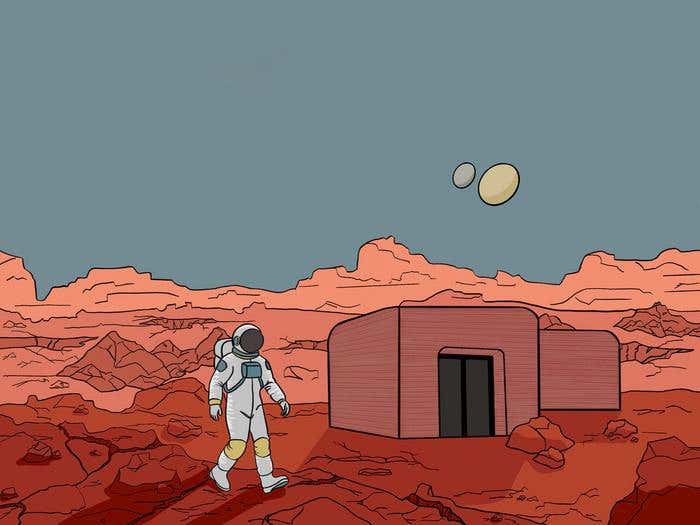Scientists develop new process to build homes on Mars using fungi and bacteria
Texas A&M scientists create living materials to build Martian homes using fungi and cyanobacteria without human help.

Texas A&M scientists create living materials to build Martian homes using fungi and cyanobacteria without human help. (CREDIT: Texas A&M University)
Landing on Mars once felt like a distant dream. Now, space agencies have sent rovers and landers to explore the Red Planet for decades. Scientists worldwide are thinking about how to make Mars a second home for humans. But a major question remains: how do you build structures millions of miles from Earth?
Shipping heavy loads of building materials to Mars is expensive and impractical. Rockets have limited space and fuel, and sending cement or metal beams would cost billions. Researchers are now exploring ways to use what Mars already has – its soil, dust, and natural resources – to build homes for future astronauts.
At Texas A&M University, Dr. Congrui Grace Jin and her team are tackling this challenge. They have spent years developing bio-manufacturing methods to create engineered living materials. Their latest research proposes a solution that could change how humans build structures on other planets.
“We can build a synthetic community by mimicking natural lichens,” explains Jin. “We’ve developed a way to build synthetic lichens to create biomaterials that glue Martian regolith particles into structures. Then, through 3D printing, a wide range of structures can be fabricated, such as buildings, houses and furniture.”
The Power of Synthetic Lichens
Jin’s team, working with the University of Nebraska-Lincoln, has designed a synthetic lichen system. This system forms strong building materials without any help from humans.
Martian regolith is the loose soil, dust, sand, and broken rocks on Mars’ surface. Their research shows that a synthetic community of organisms can turn regolith into building materials strong enough for homes, tables, and chairs. This breakthrough may one day allow humans to build on Mars without sending extra materials from Earth.
Related Stories
Other scientists have studied different ways to bond Martian soil. Some tried using magnesium-based, sulfur-based, or geopolymer methods. However, all these approaches need humans to carry out parts of the process. On Mars, there won’t be enough people to oversee these complicated tasks.
Another approach is called microbe-mediated self-growing technology. This uses bacteria or fungi to produce minerals and bind soil particles into bricks. NASA has explored using fungal mycelium as a bonding agent, while other scientists have tested bacteria that produce calcium carbonate. But even these methods require outside nutrients to keep the microbes alive, needing human intervention.
A Self-Sustaining Living System
Jin’s team wanted to solve this problem. Their idea was simple yet powerful: build a system that runs on its own using organisms that help each other survive. They created a synthetic lichen system that combines two types of microorganisms – filamentous fungi and diazotrophic cyanobacteria.
Filamentous fungi act as the builders. They can produce large amounts of biominerals to bond soil particles. These fungi survive harsh conditions better than bacteria. They also bind metal ions onto their cell walls, creating sites for biomineral crystals to grow. At the same time, they help the cyanobacteria grow by giving them water, minerals, and carbon dioxide.
Diazotrophic cyanobacteria act as the providers. They fix carbon dioxide and dinitrogen from the air and turn them into oxygen and organic nutrients. This process feeds the fungi and increases carbonate ions in the environment. The carbonate ions are essential for creating mineral crystals that bond the soil together. The cyanobacteria also use photosynthesis to produce the nutrients needed for the fungi to thrive.
Both organisms secrete biopolymers that help glue regolith particles and mineral crystals into strong, solid materials. Their relationship is mutually beneficial. Together, they form a system that requires only Martian regolith simulant, air, light, and an inorganic liquid medium to grow. No external carbon or nitrogen sources are needed.
“The potential of this self-growing technology in enabling long-term extraterrestrial exploration and colonization is significant,” states Jin.
3D Printing Martian Homes
The team’s next goal is to create regolith ink for 3D printing. This method, known as direct ink writing, uses thick paste-like material to print structures layer by layer. Imagine printing a home out of clay, but with bio-based Martian concrete instead.
As scientists explore the possibility of colonizing Mars, it becomes clear that sending pre-built structures from Earth is not practical. The journey is too long, the loads too heavy, and the environment too harsh. Future habitats must be built using materials found on the planet itself.
Jin’s research shows that microorganisms can become builders. They can work with local resources to produce solid structures autonomously. This is a radical shift from traditional construction. Rather than bringing materials, humans can bring living systems that make materials on-site.
Designing for Extreme Environments
Mars is not an easy place to live. Temperatures drop far below freezing. Dust storms cover the surface with fine particles that could damage equipment. There is little oxygen, and the air pressure is less than one percent of Earth’s.
Traditional building methods won’t work under these conditions. Prefabricated structures are hard to transport. Assembling them in such an extreme environment is risky. Jin’s team is working to change this by creating technologies that adjust to restricted resources and harsh conditions.
Their synthetic lichen system mimics natural lichens on Earth. In nature, lichens are made of fungi and algae or cyanobacteria living together. They survive on rocks and in harsh environments, from deserts to frozen tundra. The fungi provide structure and protection, while the cyanobacteria or algae produce food through photosynthesis.
In this research, diazotrophic cyanobacteria fix carbon dioxide and dinitrogen from the atmosphere to make oxygen and nutrients. The fungi bind metal ions and produce biominerals. Together, they create a strong, stone-like material from loose soil.
The system’s benefits extend beyond strength. It is self-sustaining, meaning humans would not need to feed the organisms constantly. This saves costs, reduces supply missions, and makes Mars colonization more realistic.
A Future Built by Microbes
Jin and her team believe this technology could be a game changer. Instead of viewing construction as a purely mechanical process, their work turns it into a biological one. Microorganisms become construction workers, builders, and providers all at once.
This innovation could open the door to building not only on Mars but also on other planets or moons. Anywhere with regolith and sunlight could support these living construction systems. It also reduces the risks faced by astronauts who would otherwise need to perform dangerous assembly tasks in spacesuits.
The research was funded by NASA because of its potential to solve real problems in space exploration. As missions move closer to sending humans to Mars, the need for safe, reliable shelters will grow.
For now, the team continues testing their synthetic lichen system using Martian regolith simulants. They are refining the regolith ink to make sure it can be used with 3D printers. The ultimate goal is to have a system that can be loaded onto a spacecraft and activated upon arrival. It would then grow itself into a shelter, ready for the first humans to set foot on the planet.
In the coming decades, human colonies on Mars may not be built with metal and cement but with the help of microorganisms working in harmony. This technology could redefine construction, bringing biology and engineering together in ways never imagined before.
The study, funded by NASA’s Innovative Advanced Concepts program, was recently published in the Journal of Manufacturing Science and Engineering.
Note: The article above provided above by The Brighter Side of News.
Like these kind of feel good stories? Get The Brighter Side of News' newsletter.



